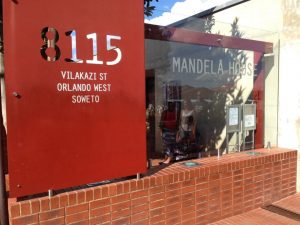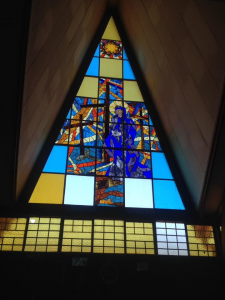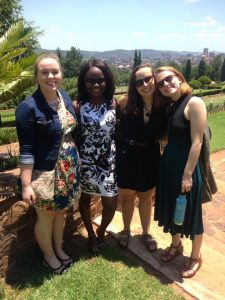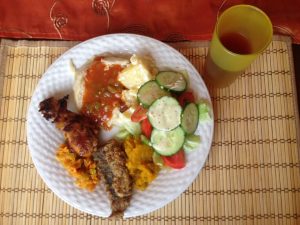Blogger: Katie Karstensen
Program: Windhoek, Namibia
Lowell, Indiana → Chicago → Washington D.C. → Ghana → Johannesburg, South Africa
An early morning take off from Chicago to Washington D.C.
I’m constantly thankful that I’ve been instilled with a sense of adventure from a young age. I didn’t have the opportunity to travel outside of the Midwest before college, yet I was constantly outside hiking, attending camp, or even playing outside on my farm. Valparaiso University has granted me travel opportunities I am forever thankful for, and it is one of the reasons I decided to attend this school. I’ve known I wanted to study abroad since my freshman year and enjoyed the process of deciding where I wanted to go and which program would be the best fit for me. That process has led me to a semester in Southern Africa with a program through the Center for Global Education at Augsburg College, called Nation Building, Globalization and Decolonizing the Mind. For the next three and a half months, I will be exploring Southern Africa, learning about the history and its effects in this area, taking classes, and working at internship with Family of Hope Services in Windhoek, Namibia.
Our first few days in Johannesburg entailed getting a crash course in the history of South Africa, the role of Apartheid, and a focus in the role youth have played in the country’s history. We visited Nelson Mandela’s house, the U.S. Embassy, Apartheid Museum, the Hector Pieterson Memorial, and Regina Mundi. My first impression of Johannesburg were the vast amount of contrasts we encountered. During our driving tour, our group went through a rich subdivision, which had experienced white flight after Apartheid, and viewed large houses with extravagant gardens and maximum security. Then looking in the other direction across a field, there were a collection of tin shacks families were residing in.
In communication with local residents, South Africans know the United State’s political system in and out. In contrast, only one or two student in my group knew who the president of South Africa was, or that there are more than two political parties. The trend of finding contradictions has continued throughout my time here.
An exhibit from the Apartheid museum. Upon entering the museum, visitors were randomly given tickets saying “white” or “non-whites.” After receiving our ticket we had to enter in two different entrances according to our race.
June 16th Children’s Memorial, the route in which children marched and rioted in the streets. The accounts presented in the museum are from government records, due to government funding. The actual events of the day involved much more violence and blood from police officers towards students.
One of the stained glass windows at Regina Mundi, a church where the students involved in the June 16th march took refuge amidst the riot. Police shot at the walls of the church from the outside and banged their guns against the marble altar hard enough to chip off its edges to scare the students, but no students were shot within the walls of the church.
This particular window shows the image of a saint whose race appears to be white from the inside, and black from the outside.
The first weekend in South Africa, our group was divided into pairs and hosted by families across the city of Johannesburg and Soweto. I stayed with a family where both parents worked for the police station, and had two children ages eight and fourteen. The family has been working with CGEE(Center for Global Education) for many years and welcomed my friend Emily and I into their homes as if we were their own children. Another difference I repeatedly notice is the lack of language education we have in the United States compared to other countries. Everyone I have met in this country speaks multiple languages including English, Afrikaans, French, German, Spanish, Xhosa, Damara Nama, and usually a few other African dialects. My host father speaks thirty languages and explains he needs to know them so he is able to communicate with everyone he comes in contact with through his criminal intelligence office. As we strolled through a market together, he bartered with five different women for vegetables and fruit, and after speaking to each told me which language they had been speaking in, all five speaking different native tongues and our father replying at ease to them.
Another favorite part of my homestay was the food. Food is generally a favorite part of my life, and cooking with my host mother and trying unfamiliar foods was a favorite part of my homestay as well. Every meal consisted of pop, a grain that is comparable to the texture of thick mashed potatoes. We ate with our hands and used pop to stick to our other foods and eat. I became an expert at making pop and chakalaka, a spicy vegetable mixture. While being in Southern Africa, I have also discovered my favorite tea. It is called Rooibos, a red tea that can be found in every household and restaurant here.
View from Top of Africa at the Carlton Center, the tallest building in Johannesburg
Dinner I helped to prepare at my homestay. On Sundays my host family has “seven colors meals.” They prepare a dish that consists of seven different colored foods, so may add foods like beets, carrots, squash, tomatoes, and other foods so they have a larger variety.








Leave a Reply